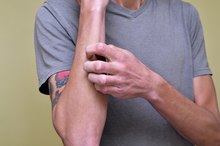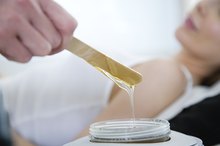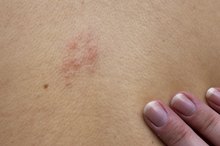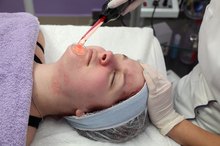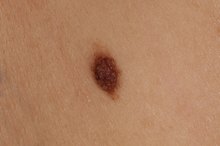How to Get Rid of Stitch Scars on the Face
Stitches are necessary if your skin cannot heal on its own after injury or surgical procedures. Since this disrupts your skin's natural healing process, the adjoining skin and stitched area may have a residual scar once healed. Ridding yourself of stitch scars on your face depends on size and severity. At-home methods may be feasible, or you may have to visit a surgeon to see about more sophisticated procedures.
Massage the affected area gently once the skin is healed and stitches have been removed. This breaks down dense areas that are more prone to scar formation from stitches. It also increases blood circulation to the skin, helping it heal more quickly. Massage the area for a few minutes throughout the day.
How to Get Rid of Scars From Belly Piercings
Learn More
Exfoliate your facial skin twice a week. You can use either an exfoliating scrub or brush to get rid of the dead skin cells. Gently rub area in small circular motions to slough off the damaged layers. Results are not immediate, but with frequent use, exfoliation can reduce the appearance and get rid of stitch scars.
Ask your dermatologist about dermabrasion 2. The procedure sands away the damaged outer skin layers with a special instrument, allowing smoother, healthier skin to replace it. Dermabrasion is only done once to see results and healing time may vary from a couple of weeks to a couple of months.
How to Get Rid of Scratch Scars
Learn More
Schedule a laser treatment to remove damaged portions of skin. Once the laser is applied, it burns off scar tissue so that fresher skin underneath can emerge. This treatment has very few side effects aside from mild inflammation, usually treated with over the counter analgesics. You may need several treatments before the stitch scars fade away.
Related Articles
References
- Columbia University: Embarrassing scars — how can I get rid of them?
- American Academy of Dermatology: What is a Scar
- Saint-jean M, Khammari A, Jasson F, Nguyen JM, Dréno B. Different cutaneous innate immunity profiles in acne patients with and without atrophic scars. Eur J Dermatol. 2016;26(1):68-74. doi:10.1684/ejd.2015.2713
- Archer CB, Cohen SN, Baron SE. Guidance on the diagnosis and clinical management of acne. Clin Exp Dermatol. 2012;37 Suppl 1:1-6. doi:10.1111/j.1365-2230.2012.04335.x
- Woolery-lloyd H, Kammer JN. Treatment of hyperpigmentation. Semin Cutan Med Surg. 2011;30(3):171-5. doi:10.1016/j.sder.2011.06.004
- Hedelund L, Haak CS, Togsverd-bo K, Bogh MK, Bjerring P, Haedersdal M. Fractional CO2 laser resurfacing for atrophic acne scars: a randomized controlled trial with blinded response evaluation. Lasers Surg Med. 2012;44(6):447-52. doi:10.1002/lsm.22048
- Hedelund L, Moreau KE, Beyer DM, Nymann P, Haedersdal M. Fractional nonablative 1,540-nm laser resurfacing of atrophic acne scars. A randomized controlled trial with blinded response evaluation. Lasers Med Sci. 2010;25(5):749-54. doi:10.1007/s10103-010-0801-1
- Kim EK, Hovsepian RV, Mathew P, Paul MD. Dermabrasion. Clin Plast Surg. 2011;38(3):391-5, v-vi. doi:10.1016/j.cps.2011.05.001
- Wollina U, Goldman A. Fillers for the improvement in acne scars. Clin Cosmet Investig Dermatol. 2015;8:493-9. doi:10.2147/CCID.S86478
- Fabbrocini G, Annunziata MC, D'arco V, et al. Acne scars: pathogenesis, classification and treatment. Dermatol Res Pract. 2010;2010:893080. doi:10.1155/2010/893080
- Alexiades M. "Laser and Light-Based Treatments of Acne and Acne Scarring." Clinics in Dermatology. 2017 Mar - Apr;35(2):183-189.
- Fife D. "Evaluation of Acne Scars: How to Assess Them and What to Tell the Patient." Dermatologic Clinics. 2016 Apr;34(2):207-13.
- Werschler WP, Few JW, Jacob CI, Joseph JH, Spencer JM, Taub AF. "Advancing the Care of Post-Acne Scarring: Expert Insights Into New Treatment Options." Journal of Drugs in Dermatology. 2016 May 1;15(5):518-25.
- Zaleski-Larsen LA, Fabi SG, McGraw T, Taylor M. "Acne Scar Treatment: A Multimodality Approach Tailored to Scar Type." Dermatologic Surgery. 2016 May;42 Suppl 2:S139-49.
- Zouboulis CC, Bettoli V. "Management of Severe Acne." British Journal of Dermatology. 2015 Jul;172 Suppl 1:27-36.
Writer Bio
David Friedman began writing professionally in 2004. His work appears in the "Daily Illini" and various websites. Friedman is a certified personal trainer through the American College of Sports Medicine and has Bachelor of Science in exercise science from University of Illinois at Urbana-Champaign.

